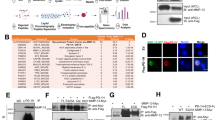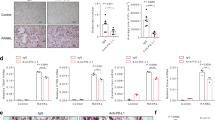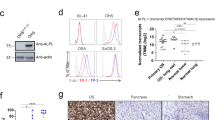Abstract
APRIL (a proliferation-inducing Ligand) and BLyS/BAFF (B-lymphocyte stimulator/B-cell-activating factor of the TNF (tumor necrosis factor) family have been shown to be the survival factors for certain myeloma cells in vitro. BAFF binds to the TNF-related receptors such as B-cell maturation antigen (BCMA), transmembrane activator and CAML interactor (TACI) and BAFFR, whereas APRIL binds to TACI and BCMA and to heparan sulfate proteoglycans (HSPG) such as syndecan-1. TACI gene expression in myeloma reportedly can distinguish tumors with a signature of microenvironment dependence (TACIhigh) versus a plasmablastic signature (TACIlow). We tested the effect of atacicept (formerly TACI-Ig, which blocks APRIL and BAFF) and BAFFR-Ig (which blocks BAFF only) on primary myeloma growth in the SCID-hu model and in coculture with osteoclasts. With only few exceptions, atacicept and to a lesser extent BAFFR-Ig, inhibited growth of TACIhigh but not TACIlow myeloma samples in vivo and ex vivo, and the response rate was inversely correlated with TACI expression. Most TACIhigh myeloma cells were molecularly classified as being low risk with our recently described 70-gene model. APRIL and BAFF were highly expressed by osteoclasts and were upregulated in myeloma cells after coculture with osteoclasts. Our findings suggest that APRIL plays an essential role in the survival of TACIhigh bone marrow-dependent myeloma cells and TACI gene expression may be a useful predictive marker for patients who could benefit from atacicept treatment.
This is a preview of subscription content, access via your institution
Access options
Subscribe to this journal
Receive 12 print issues and online access
$259.00 per year
only $21.58 per issue
Buy this article
- Purchase on Springer Link
- Instant access to full article PDF
Prices may be subject to local taxes which are calculated during checkout





Similar content being viewed by others
References
Mitsiades CS, Mitsiades NS, Munshi NC, Richardson PG, Anderson KC . The role of the bone microenvironment in the pathophysiology and therapeutic management of multiple myeloma: interplay of growth factors, their receptors and stromal interactions. Eur J Cancer 2006; 42: 1564–1573.
Hazlehurst LA, Landowski TH, Dalton WS . Role of the tumor microenvironment in mediating de novo resistance to drugs and physiological mediators of cell death. Oncogene 2003; 22: 7396–7402.
Singhal S, Mehta J, Desikan R, Ayers D, Roberson P, Eddlemon P et al. Antitumor activity of thalidomide in refractory multiple myeloma. N Engl J Med 1999; 341: 1565–1571.
Richardson PG, Barlogie B, Berenson J, Singhal S, Jagannath S, Irwin D et al. A phase 2 study of bortezomib in relapsed, refractory myeloma. N Engl J Med 2003; 348: 2609–2617.
Bataille R, Jourdan M, Zhang XG, Klein B . Serum levels of interleukin 6, a potent myeloma cell growth factor, as a reflect of disease severity in plasma cell dyscrasias. J Clin Invest 1989; 84: 2008–2011.
Chauhan D, Uchiyama H, Akbarali Y, Urashima M, Yamamoto K, Libermann TA et al. Multiple myeloma cell adhesion-induced interleukin-6 expression in bone marrow stromal cells involves activation of NF-kappa B. Blood 1996; 87: 1104–1112.
Gunn WG, Conley A, Deininger L, Olson SD, Prockop DJ, Gregory CA . A crosstalk between Myeloma cells and marrow stromal cells stimulates production of DKK1 and IL-6: a potential role in the development of lytic bone disease and tumor progression in multiple myeloma. Stem Cells 2006; 24: 986–991.
Podar K, Anderson KC . The pathophysiologic role of VEGF in hematologic malignancies: therapeutic implications. Blood 2005; 105: 1383–1395.
Moreau P, Harousseau JL, Wijdenes J, Morineau N, Milpied N, Bataille R . A combination of anti-interleukin 6 murine monoclonal antibody with dexamethasone and high-dose melphalan induces high complete response rates in advanced multiple myeloma. Br J Haematol 2000; 109: 661–664.
Kovacs MJ, Reece DE, Marcellus D, Meyer RM, Mathews S, Dong RP et al. A phase II study of ZD6474 (Zactima, a selective inhibitor of VEGFR and EGFR tyrosine kinase in patients with relapsed multiple myeloma—NCIC CTG IND.145. Invest New Drugs 2006; 24: 529–535.
Dillon SR, Gross JA, Ansell SM, Novak AJ . An APRIL to remember: novel TNF ligands as therapeutic targets. Nat Rev Drug Discov 2006; 5: 235–246.
Jelinek DF, Darce JR . Human B lymphocyte malignancies: exploitation of BLyS and APRIL and their receptors. Curr Dir Autoimmun 2005; 8: 266–288.
Shivakumar L, Ansell S . Targeting B-lymphocyte stimulator/B-cell activating factor and a proliferation-inducing ligand in hematologic malignancies. Clin Lymphoma Myeloma 2006; 7: 106–108.
Moreaux J, Legouffe E, Jourdan E, Quittet P, Reme T, Lugagne C et al. BAFF and APRIL protect myeloma cells from apoptosis induced by interleukin 6 deprivation and dexamethasone. Blood 2004; 103: 3148–3157.
Novak AJ, Darce JR, Arendt BK, Harder B, Henderson K, Kindsvogel W et al. Expression of BCMA, TACI, and BAFF-R in multiple myeloma: a mechanism for growth and survival. Blood 2004; 103: 689–694.
Tai YT, Li XF, Breitkreutz I, Song W, Neri P, Catley L et al. Role of B-cell-activating factor in adhesion and growth of human multiple myeloma cells in the bone marrow microenvironment. Cancer Res 2006; 66: 6675–6682.
Moreaux J, Cremer FW, Reme T, Raab M, Mahtouk K, Kaukel P et al. The level of TACI gene expression in myeloma cells is associated with a signature of microenvironment dependence versus a plasmablastic signature. Blood 2005; 106: 1021–1030.
Abe M, Kido S, Hiasa M, Nakano A, Oda A, Amou H et al. BAFF and APRIL as osteoclast-derived survival factors for myeloma cells: a rationale for TACI-Fc treatment in patients with multiple myeloma. Leukemia 2006; 20: 1313–1315.
Kukreja A, Hutchinson A, Dhodapkar K, Mazumder A, Vesole D, Angitapalli R et al. Enhancement of clonogenicity of human multiple myeloma by dendritic cells. J Exp Med 2006; 203: 1859–1865.
Yaccoby S, Barlogie B, Epstein J . Primary myeloma cells growing in SCID-hu mice: a model for studying the biology and treatment of myeloma and its manifestations. Blood 1998; 92: 2908–2913.
Yaccoby S, Epstein J . The proliferative potential of myeloma plasma cells manifest in the SCID-hu host. Blood 1999; 94: 3576–3582.
Yaccoby S, Wezeman MJ, Henderson A, Cottler-Fox M, Yi Q, Barlogie B et al. Cancer and the microenvironment: myeloma-osteoclast interactions as a model. Cancer Res 2004; 64: 2016–2023.
Yaccoby S . The phenotypic plasticity of myeloma plasma cells as expressed by dedifferentiation into an immature, resilient, and apoptosis-resistant phenotype. Clin Cancer Res 2005; 11: 7599–7606.
Yaccoby S, Pearse RN, Johnson CL, Barlogie B, Choi Y, Epstein J . Myeloma interacts with the bone marrow microenvironment to induce osteoclastogenesis and is dependent on osteoclast activity. Br J Haematol 2002; 116: 278–290.
Yaccoby S, Johnson CL, Mahaffey SC, Wezeman MJ, Barlogie B, Epstein J . Antimyeloma efficacy of thalidomide in the SCID-hu model. Blood 2002; 100: 4162–4168.
Yaccoby S, Wezeman MJ, Zangari M, Walker R, Cottler-Fox M, Gaddy D et al. Inhibitory effects of osteoblasts and increased bone formation on myeloma in novel culture systems and a myelomatous mouse model. Haematologica 2006; 91: 192–199.
Zhan F, Hardin J, Kordsmeier B, Bumm K, Zheng M, Tian E et al. Global gene expression profiling of multiple myeloma, monoclonal gammopathy of undetermined significance, and normal bone marrow plasma cells. Blood 2002; 99: 1745–1757.
Zhan F, Huang Y, Colla S, Stewart JP, Hanamura I, Gupta S et al. The molecular classification of multiple myeloma. Blood 2006; 108: 2020–2028.
Shaughnessy Jr JD, Zhan F, Burington BE, Huang Y, Colla S, Hanamura I et al. A validated gene expression model of high-risk multiple myeloma is defined by deregulated expression of genes mapping to chromosome 1. Blood 2007; 109: 2276–2284.
Yaccoby S, Ling W, Zhan F, Walker R, Barlogie B, Shaughnessy JD, Jr . Antibody-based inhibition of DKK1 suppresses tumor-induced bone resorption and multiple myeloma growth in vivo. Blood 2007; 109: 2106–2111.
Ge Y, Zhan F, Barlogie B, Epstein J, Shaughnessy J, Yaccoby Y . Fibroblast activation protein (FAP) is upregulated in myelomatous bone and supports myeloma cell survival. Br J Haematol 2006; 133: 83–92.
Colla S, Zhan F, Xiong W, Wu X, Xu H, Stephens O et al. The oxidative stress response regulates DKK1 expression through the JNK signaling cascade in multiple myeloma plasma cells. Blood 2007; 109: 4470–4477.
Moreaux J, Legouffe E, Jourdan E, Quittet P, Reme T, Lugagne C et al. BAFF and APRIL protect myeloma cells from apoptosis induced by interleukin 6 deprivation and dexamethasone. Blood 2004; 103: 3148–3157.
Ingold K, Zumsteg A, Tardivel A, Huard B, Steiner QG, Cachero TG et al. Identification of proteoglycans as the APRIL-specific binding partners. J Exp Med 2005; 201: 1375–1383.
Hendriks J, Planelles L, de Jong-Odding J, Hardenberg G, Pals ST, Hahne M et al. Heparan sulfate proteoglycan binding promotes APRIL-induced tumor cell proliferation. Cell Death Differ 2005; 12: 637–648.
Sanderson RD, Yang Y, Kelly T, MacLeod V, Dai Y, Theus A . Enzymatic remodeling of heparan sulfate proteoglycans within the tumor microenvironment: growth regulation and the prospect of new cancer therapies. J Cell Biochem 2005; 96: 897–905.
Yang Y, Yaccoby S, Liu W, Langford JK, Pumphrey CY, Theus A et al. Soluble syndecan-1 promotes growth of myeloma tumors in vivo. Blood 2002; 100: 610–617.
Yang Y, MacLeod V, Dai Y, Khotskaya-Sample Y, Shriver Z, Venkataraman G et al. The syndecan-1 heparan sulfate proteoglycan is a viable target for myeloma therapy. Blood 2007; 110: 2041–2048.
Bischof D, Elsawa SF, Mantchev G, Yoon J, Michels GE, Nilson A et al. Selective activation of TACI by syndecan-2. Blood 2006; 107: 3235–3242.
Roodman GD . Mechanisms of bone metastasis. N Engl J Med 2004; 350: 1655–1664.
Croucher PI, De Hendrik R, Perry MJ, Hijzen A, Shipman CM, Lippitt J et al. Zoledronic acid treatment of 5T2MM-bearing mice inhibits the development of myeloma bone disease: evidence for decreased osteolysis, tumor burden and angiogenesis, and increased survival. J Bone Miner Res 2003; 18: 482–492.
Abe M, Hiura K, Wilde J, Shioyasono A, Moriyama K, Hashimoto T et al. Osteoclasts enhance myeloma cell growth and survival via cell-cell contact: a vicious cycle between bone destruction and myeloma expansion. Blood 2004; 104: 2484–2491.
Acknowledgements
This work was supported by Grants CA-93897 (SY), CA55819 (BB and JS), and CA97513 (JS) from the National Cancer Institute, by Senior and Translational Research Awards from the Multiple Myeloma Research Foundation (SY) and by a grant from ZymoGenetics Inc. and Merck-Serono International, SA (JS and SY). SY performed research, analyzed and interpreted data, and wrote the paper. AP and XL performed research experiments. SRD provided materials, analyzed and interpreted data. FZ analyzed all microarray data. BB contributed resources including patient material and clinical data. JS conceptualized the work, analyzed and interpreted data. We recognize the efforts of the members of Dr Yaccoby's laboratory; Rinku Saha, Wen Ling and Paul Perkins, and Derek Janszen (ZymoGenetics Inc.) for his assistance with the statistical analysis. We also thank the faculty, staff and patients of the Myeloma Institute for Research and Therapy for their support.
Author information
Authors and Affiliations
Corresponding author
Rights and permissions
About this article
Cite this article
Yaccoby, S., Pennisi, A., Li, X. et al. Atacicept (TACI-Ig) inhibits growth of TACIhigh primary myeloma cells in SCID-hu mice and in coculture with osteoclasts. Leukemia 22, 406–413 (2008). https://doi.org/10.1038/sj.leu.2405048
Received:
Revised:
Accepted:
Published:
Issue Date:
DOI: https://doi.org/10.1038/sj.leu.2405048
Keywords
This article is cited by
-
BCMA-targeting chimeric antigen receptor T cell therapy for relapsed and/or refractory multiple myeloma
Annals of Hematology (2024)
-
Cross center single-cell RNA sequencing study of the immune microenvironment in rapid progressing multiple myeloma
npj Genomic Medicine (2023)
-
BCMA-targeted immunotherapy for multiple myeloma
Journal of Hematology & Oncology (2020)
-
APRIL signaling via TACI mediates immunosuppression by T regulatory cells in multiple myeloma: therapeutic implications
Leukemia (2019)
-
Chimeric antigen receptor T cell targeting B cell maturation antigen immunotherapy is promising for multiple myeloma
Annals of Hematology (2019)



